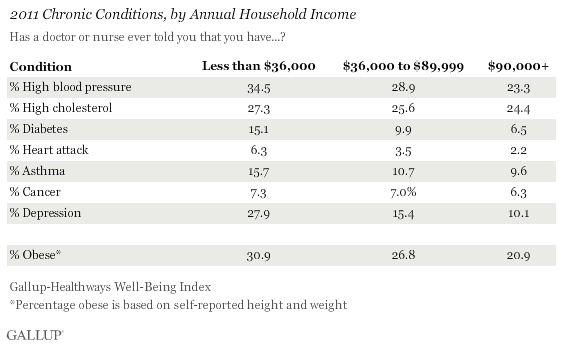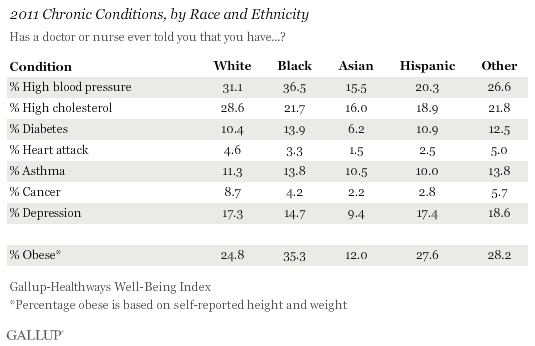WASHINGTON, D.C. -- American adults were slightly less likely in 2011 than they were in 2010 to say they have ever been diagnosed with high blood pressure, high cholesterol, diabetes, or a heart attack, while lifetime diagnoses of asthma and cancer were unchanged. High blood pressure continues to be the most common chronic condition reported in the United States, with 3 in 10 American adults who say they have been diagnosed with it.

The slight decline in some chronic conditions mirrors the decrease in obesity levels in 2011. However, as with obesity, the prevalence of high blood pressure is still slightly higher than it was in 2008.
Gallup tracks chronic conditions in the United States on a daily basis as part of the Gallup-Healthways Well-Being Index, surveying more than 350,000 American adults per year. Gallup asks respondents if a physician or nurse has ever diagnosed them with any of the seven conditions.
Young Adults Still Healthiest in 2011 and Most Improved Since 2008
Younger adults in the U.S. remain less likely than those aged 30 and older to report high blood pressure, high cholesterol, diabetes, heart attacks, and cancer.
Further, young adults' reports of high blood pressure, high cholesterol, diabetes, and cancer have declined significantly since 2008. Similarly, the percentage of young adults who were obese in 2011 declined to match 2008, after inching up in 2009 and 2010.
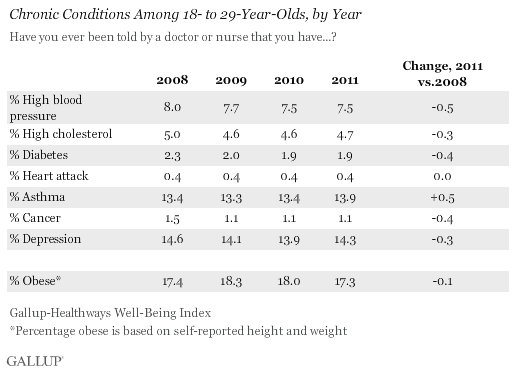
Americans aged 30 to 44 were more likely to report high blood pressure and to be obese in 2011 than in 2008. High cholesterol in this age group, however, was lower in 2011 than in 2008, with the rate falling below 15% for the first time since Gallup and Healthways started measuring it.
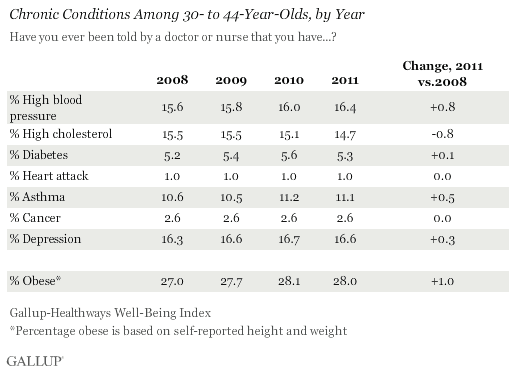
The percentage of Americans aged 45 to 64 who report having ever been diagnosed with high blood pressure and diabetes was up in 2011 compared with 2008 -- mirroring a similar increase in this group's obesity rate.
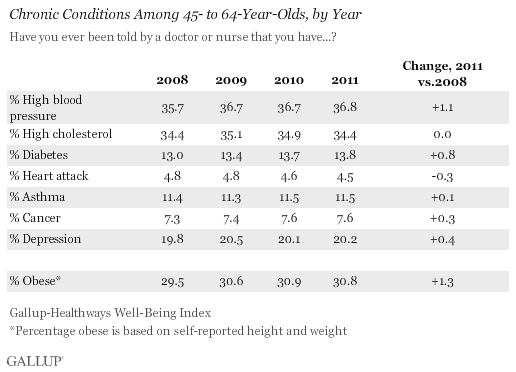
The percentage of seniors who are obese has also increased since 2008, as have the percentages who report having ever been diagnosed with high blood pressure, high cholesterol, diabetes, and cancer. Notably though, the percentage of seniors reporting they have had a heart attack decreased to 12% in 2011, from 13.2% in 2008.
Older Americans, though, continue to be less likely than young adults to report having ever been diagnosed with asthma.
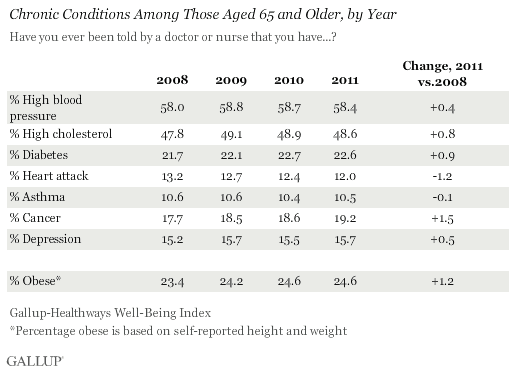
To view chronic condition rates by additional demographic groups, see page 2.
Implications
The adult obesity rate in the United States declined slightly in 2011, but the effects of this positive turnaround on chronic conditions will take time to emerge. At this time, trends since 2008 reveal that it appears that young adults are leading the way in bringing down the nation's rates of chronic diseases, while seniors are struggling. Seniors were more likely to report several chronic diseases in 2011 compared with 2008. Young adults, however, were slightly less likely to report high blood pressure, high cholesterol, and diabetes.
Still, the changes over time in these conditions have been small and the cause remains unclear. Increases and decreases can be the result of changes in medical coverage, screening rates, doctors' visits, and other factors distinct from the actual underlying presence of disease.
About the Gallup-Healthways Well-Being Index
The Gallup-Healthways Well-Being Index tracks well-being in the U.S., U.K., and Germany and provides best-in-class solutions for a healthier world. To learn more, please visit well-beingindex.com.
Survey Methods
Results are based on telephone interviews conducted as part of the Gallup-Healthways Well-Being Index surveys each day, with a random sample of 1,000 adults, or about 353,000 adults per year, aged 18 and older, living in all 50 U.S. states and the District of Columbia, selected using random-digit-dial sampling.
For yearly results based on the total sample of national adults, one can say with 95% confidence that the maximum margin of sampling error is ±0.2 percentage point.
For any given age group, the maximum margin of sampling error range is no greater than ±0.6 percentage point.
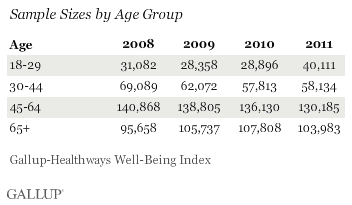
Interviews are conducted with respondents on landline telephones and cellular phones, with interviews conducted in Spanish for respondents who are primarily Spanish-speaking. Each sample includes a minimum quota of 400 cell phone respondents and 600 landline respondents per 1,000 national adults, with additional minimum quotas among landline respondents by region. Landline telephone numbers are chosen at random among listed telephone numbers. Cell phone numbers are selected using random-digit-dial methods. Landline respondents are chosen at random within each household on the basis of which member had the most recent birthday.
Samples are weighted by gender, age, race, Hispanic ethnicity, education, region, adults in the household, and phone status (cell phone only/landline only/both, cell phone mostly, and having an unlisted landline number). Demographic weighting targets are based on the March 2010 Current Population Survey figures for the aged 18 and older non-institutionalized population living in U.S. telephone households. All reported margins of sampling error include the computed design effects for weighting and sample design.
In addition to sampling error, question wording and practical difficulties in conducting surveys can introduce error or bias into the findings of public opinion polls.
For more details on Gallup's polling methodology, visit www.gallup.com.

